“What kinds of horseback riding and activities are there?” “How many equestrian sports are there?” Questions I am sure you are interested in
These are called horse riding disciplines or horse disciplines because not all include riding.
There are some horse disciplines that are less commonly known and some that are rarely known.
Most equestrians participate in one of the common mainstream riding discipline types that fall under the English or Western style riding.
Some horse disciplines are debated as controversial in the equestrian world, and some disciplines you have to have the right opportunity to participate in.
In this article, I am going to mention many of the different equine disciplines active today, both on and off the horse, and share a little bit about each of the activities.
I’ll also try to answer most of the frequently asked questions about different types of horseback riding and activities.
Not every discipline known to man will be mentioned here, but I know you will find at least one, if not more, that you have never heard of before.
Maybe you will find one that you are interested in trying out.

Quick Overview List Of Horse Disciplines
English Riding Styles
- Classical Dressage
- Contemporary Dressage
- Show Jumping
- Eventing
- Hunter Jumper
- Equitation
- English Pleasure
- Saddle Seat
- Speed Racking
- Foxhunting
Western Style Discipline List
- Western Pleasure
- Western Dressage
- Reining
- Barrel Racing
- Team Penning
- Versatility Western Ranch Riding
- Pole bending
- Western Working Equitation
- Cutting
- Roping
- Breakaway Roping
- Western Trail Riding
- Team Sorting
- Gymkhana
List Of Racing Discipline
- Thoroughbred Flat Racing
- Quarter Horse Races
- Shetland Pony Races
- Harness Racing
- Steeplechase
List Of Team Disciplines
- Polo
- Pato
- Horseball
- Equestrian Drill Team
Para- Equestrian Discipline List
- Para-Dressage
- Para-Combined Driving
Driving Discipline List
- Combined Driving
- Pleasure Carriage Driving
- Roadster
List Other Horse Disciplines
- Endurance Riding
- Side Saddle
- Skijoring
- Vaulting
- Trick Riding
- Native Costume
- Trick Riding
- Icelandic Horse Riding
- Mounted Archery
- Mounted Shooting
- Halter
- Showmanship
- Miniature Horse Showing
- Liberty Horsemanship
- Hobby Horsing

What Is A Horse Discipline?
Horse disciplines are different types of activities you can do with horses, usually referring to equestrian sports, but not necessarily always on horseback.
These may be mounted or unmounted activities. Horse disciplines include all the ways that horses are used in sports, recreation, work, and even cultural activities.
As an equestrian, you can participate in one discipline or several, depending on your preference.
My Thoughts On Choosing One Discipline Over Multi-Disciplines
I have two trains of thought with this, though they are generally speaking and not talking about exceptions.
- If you choose multi-disciplines, it can make you a more well-rounded equestrian and break up the monotony. However, you may not be as skilled in a specific discipline but still be a solid overall equestrian with a bigger set of tools for training.
- If you focus on a single discipline, you can possibly achieve a higher level of skill in that discipline. Although the monotony could possibly affect your motivation or cause a plateau, there will be less experience with different methods of working with horses and a smaller training toolbox.
These two things are just my thoughts; if you are a beginner, these ideas may be beyond what you are learning, or they could just be confusing to everyone.
Let me know your thoughts about having one or more disciplines as a focus in the comments; I would love to hear them.
How Many Horse Riding Disciplines Are There?
Over 40 different horse riding disciplines exist around the world. Some of these horse disciplines do not exist except in certain countries.
Then there are non-riding disciplines as well, which include an unmounted person or a person driving a carriage.

Quick History of Horse Riding Styles
Horseback riding has been a part of human history for thousands of years. From the earliest civilizations of the Middle East to the nomadic tribes of the steppes, horses have been a cornerstone of human progress and development. Today, horseback riding is a popular pastime and sport, with many different styles of riding existing across the world.
For horse enthusiasts, it can be fascinating to explore the history of horseback riding and the various styles of riding that developed over the centuries. Let’s take a look at this interesting history and some of the different styles of horse riding.
The earliest known evidence of horseback riding dates back to 2500 BC in the steppes of Central Asia. Historians believe that the Scythians, a nomadic tribe, were the first to develop the practice of horseback riding. This practice spread to the Middle East, Europe, and eventually the Americas and other parts of the world.
For centuries, horseback riding was primarily used for warfare and transportation. Riders used simple saddles and crude bridles in order to control their horses. It wasn’t until the Renaissance period that horseback riding began to evolve beyond its utilitarian purposes and become more of an artistic pursuit.
During this period, riding academies were established to train riders of all levels and styles. Dressage, a form of horsemanship that is focused on controlling a horse’s movements and the rider’s movements, was developed in this period. This style of riding is still popular today and is used in the Olympic Games.
In the 19th century, new styles of riding emerged, including show jumping and western riding. Show jumping combines the grace and control of dressage with the power and speed of galloping, while western riding is a style of riding that is popular in the United States.
Today, there are many types of horseback riding, from classical dressage to competitive show jumping and western riding. Whether you’re a beginner or an experienced rider, there’s a style of riding out there for you. So explore the different styles that have evolved over time.

Equestrian Sports In The Olympics
Equestrian sports have been a part of the Olympics since the 1912 Stockholm Games. The three most popular equestrian sports today—dressage, show jumping, and eventing—are the same disciplines that have been contested at the Olympics since that time. Para-dressage was added to the Paralympic Games in 1996.
Dressage is the oldest and most traditional of the equestrian sports. It is sometimes referred to as “horse ballet,” and involves the horse and rider performing a series of movements in an arena. Dressage tests the horse’s natural abilities to move in a precise, graceful manner. It requires a high level of skill and harmony between horse and rider, and is often referred to as the “art of riding.”
Show jumping is a fast-paced event that tests the horse’s agility and speed. It involves the horse and rider navigating a course of obstacles, usually consisting of fences, walls, and water jumps. The goal is for the horse and rider to complete the course without knocking down any of the obstacles.
Eventing is a combination of dressage and show jumping, as well as a third phase, cross-country jumping. Eventing tests the horse and rider’s skill across all three disciplines and is considered the most demanding of the three equestrian sports. It requires the horse to be trained to respond to its rider’s commands, and the rider to demonstrate good horsemanship.
Para-dressage was introduced to the Paralympic Games in 1996. It is the same as traditional dressage, with the addition of a few special classes for riders with disabilities. The goal is to allow riders with disabilities to compete on a level playing field, and to show that they can achieve the same level of skill and harmony between horse and rider as able-bodied riders.
Equestrian sports are a unique and exciting part of the Olympic Games, and offer a great way for riders of all abilities to show off their horsemanship. Whether you’re a fan of dressage, show jumping, eventing, or para-dressage, there is something for all levels of riders to enjoy at the Olympic Games.
English Style Riding Disciplines
English riding disciplines are one of the most popular styles in the world of horsemanship. It emphasizes a steady frame and consistent contact with the horse’s mouth. It is also characterized by a balanced seat and the use of aids, such as your seat, legs, and arms, to influence the horse.
English style riding is a fantastic way to get into the world of horsemanship, and with so many disciplines to choose from, you’re sure to find one that suits your tastes and abilities.
Classical Dressage
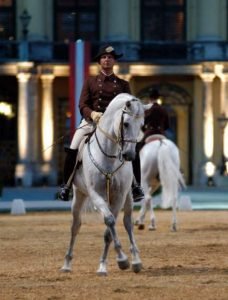
Classical dressage is an ancient art of riding that has evolved from the cavalry movements and training for the battlefield. It is a type of riding that is focused on developing a deep connection between horse and rider, and promoting the horse’s natural movement and athleticism.
At its core, classical dressage is the art of riding in harmony with the horse, rather than against it. To do this effectively, the rider needs to be in balance and must be able to move with the horse’s motion.
Classical dressage emphasizes the importance of correct and well-timed aids, so that the horse can respond to the rider’s commands in a way that is comfortable and efficient. Many of the basics of classical dressage are still used today in all forms of horsemanship.
Contemporary Dressage
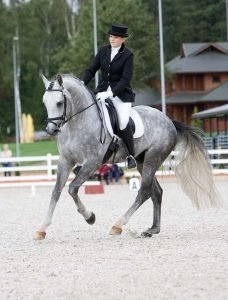
Contemporary dressage is a more modern style of dressage that has been developed over the last 40 to 50 years. It is more focused on the athleticism of the horse and rider and is judged by an objective set of criteria. A panel of judges scores each set of movements in the test. Movements in contemporary dressage are more complex and sophisticated, often featuring more difficult movements such as extended trots and flying changes. The goal of contemporary dressage is for the horse and rider to perform a sequence of movements with perfect unity, accuracy, and suppleness.
Read about benefits of simple dressage exercises and 5 to try out.
Eventing
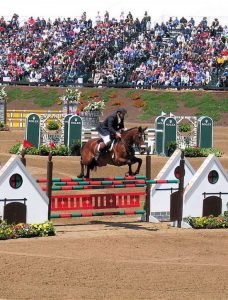
Eventing is a combination of three disciplines, including dressage, cross-country, and show jumping. The goal is to complete all three phases with the fewest total penalty points.
The dressage phase is where the horse and rider are tested on their balance, obedience, and ability to do certain moves.
The cross-country phase is designed to test the horse and rider’s speed, agility, and stamina as they navigate a course with artificial and natural obstacles. The cross country course has around 12–20 fences at the lower levels and 30–40 at the higher levels. Furthermore, the cross-country running pace must be within optimum time.
Finally, the show jumping phase tests the horse and rider’s accuracy and control as they jump over a set course.
Show Jumping
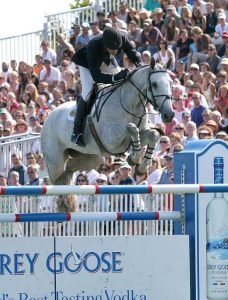
Show jumping is both a team and individual event at the international level. The goal is to complete the course with the fewest number of penalty points. The emphasis here is on speed and agility, with the horse and rider navigating challenging obstacles. Riders must jump their horses through a series of fences and other obstacles, all while maintaining a steady, balanced pace. The course is timed, and faults are assessed for any refusals, run-outs, and knockdowns. Show jumping is a great way to showcase your horse’s athleticism and skill.
Equitation Jumping
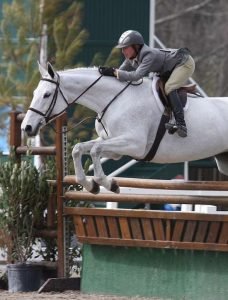
Equitation jumping is a type of horse jumping with a focus on the rider’s form and control. Riders must demonstrate good balance, timing, and control while guiding their horse over a course of obstacles. Unlike show jumping, equitation jumping does not involve speed or agility.
Hunter Jumping
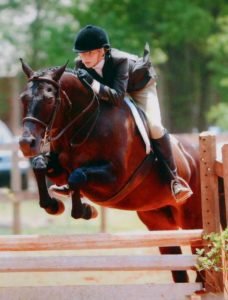
Hunter Jumping is a judged event where the horse is evaluated on its performance and style. Judges look for the horse’s form, athleticism, way of going, and ability to complete the course with ease. Horses are judged on their approach to jumps, how they take off and land, and how they maintain a consistent rhythm throughout the course. The horse should be able to complete the course in a timely fashion and with grace.
Hunter Pace
Hunter pace is a form of horse racing that combines cross-country and show jumping. Throughout the course, the rider must navigate a course of natural and artificial obstacles while maintaining a steady, balanced pace. Unlike other forms of horse jumping, hunter pace is a timed event and involves a set number of laps.
Hunt Seat On The Flat
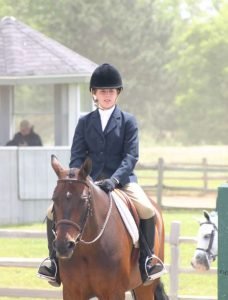
Hunt Seat is a discipline that focuses on flatwork and is typically seen in the show ring. In Hunt Seat, the horse and rider have to perform a predetermined pattern of movements, such as circles, lateral work, and changes of gait. The goal is to demonstrate that the horse is obedient and responsive to the rider’s commands.
Equitation On The Flat
Equitation is a discipline that focuses on the rider’s skill and ability to ride. Riders are judged on their ability to control the horse, as well as their balance, form, and use of the aids. It is commonly seen in the show ring and is used to evaluate riders of varying ages and levels of experience.
English Pleasure
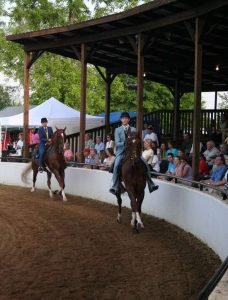
English Pleasure is a pleasure riding discipline that focuses on the horse’s conformation and movement. Riders are judged on their ability to control the horse and how well they demonstrate the horse’s potential for pleasure riding. These types of classes are available in both Hunt Seat riding and Saddle Seat riding.
Saddle Seat
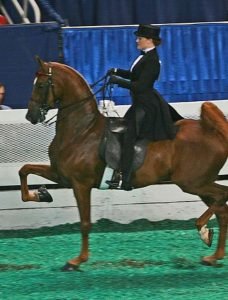
Saddle Seat is a competitive discipline that is seen in the show ring. The focus is on the horse’s action and the rider’s use of seat, leg, and hand aids. Riders must demonstrate a good position and well-executed maneuvers, while still showing the horse’s forward movement and quality of gaits.
Speed Racking
Speed racking is an exciting and dynamic equestrian sport that is quickly gaining popularity. At its core, it is a contest between horse and rider to see who can complete a course of obstacles the fastest, with the most style and precision.
At a speed racking competition, the horse and rider are judged on their performance as they maneuver through a course of obstacles. The horse must perform the three gaits of a racking horse, which include the show walk, slow rack, and fast rack, all while maintaining their form and confirmation. This requires complete coordination between horse and rider, and the team’s speed, style, and accuracy are all taken into account when determining the winner.
Fox Hunting
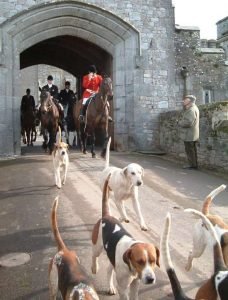
Fox hunting is an age-old activity that has been practised for centuries. It involves the tracking, chase and, if caught, the killing of a fox, traditionally a red fox, by trained foxhounds or other scent hounds.
A group of followers, led by a “master of foxhounds” (or “master of hounds”), follow the hounds on foot or on horseback. In Australia, fox hunting also refers to the hunting of foxes with firearms, similar to deer hunting.Fox hunting with hounds originated in England in the sixteenth century, and continues to be a widely practised activity in many parts of the world, including Australia, Canada, France, the Republic of Ireland and the United States. In 2002, a ban on fox hunting in Scotland came into effect and in 2005, a ban on fox hunting in England and Wales also came into effect.
Fox hunting is a highly controversial sport, particularly in the United Kingdom, sparking strong opinions from both sides of the debate. Proponents of fox hunting argue that it is an essential part of rural life, whereas opponents believe it to be cruel and unnecessary. Despite being banned in some countries, fox hunting remains a popular and much-debated activity.
Western Style Riding Disciplines
Welcome to the world of Western horse disciplines! Whether you’re a newcomer to the horse world or an experienced equestrian, there’s a western discipline that’s perfect for you. Each discipline has its own unique style, rules, and events, so let’s take a look at some of the most popular western disciplines.
Western Pleasure
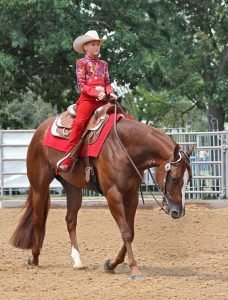
Western pleasure is all about the pleasure of the horse and rider. This discipline is focused on the comfort of both the horse and rider, as well as their ability to move in a smooth and collected manner.
Western Dressage
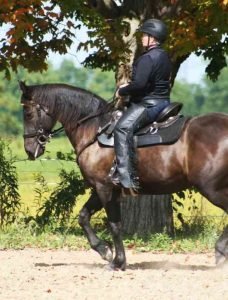
Western Dressage is an eye-catching discipline that combines classical dressage movements with western flair and style. This discipline is about showing off the horse’s natural ability to move in a harmonious and beautiful way. As far as gaits go, the horse will jog instead of trot and lope instead of canter. They have the same gaits, but they move at a much slower pace.
Reining
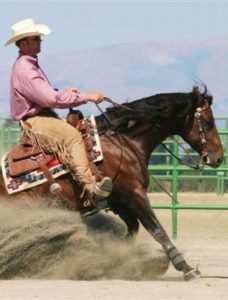
Reining is all about the horse’s agility and ability to complete an individual pattern of complex maneuvers, such as slow and fast circles, flying lead changes, 360-degree spins, and sliding stops. The horses need to do this all willingly with little or no apparent resistance. This is a great discipline for riders who are looking to challenge themselves and their horse.
Barrel Racing
Barrel racing is a rodeo discipline that combines speed and agility. The rider races around three barrels in a certain pattern and must go as fast as possible without knocking down any barrels. The rider with the fastest time with all the barrels still up is the winner. This discipline is ideal for riders who want to feel the rush of a fast-paced race.
Team Penning
Team Penning is a fast-paced discipline that requires the coordination of two riders and one horse. The goal is to move three cows from one pen to another, and it’s a great way to test your horse’s speed and agility.
Versatility Western Ranch Riding
Versatility Western ranch riding is all about showcasing the horse’s ability to perform a variety of tasks in a ranch environment. This discipline is a great way to show off your horse’s skills in areas such as cow work, trail riding, and sorting.
Pole Bending
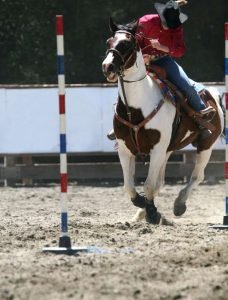
Pole bending is a fast-paced discipline that requires the horse and rider to navigate a series of poles in a specific pattern. This discipline is great for riders looking to test their horse’s speed and agility.
Western Working Equitation
Working equitation is all about the partnership between the horse and rider. This discipline combines dressage movements with obstacles such as logs, bridges, and ditches. This is a great discipline for riders looking to challenge themselves and their horse.
Cutting
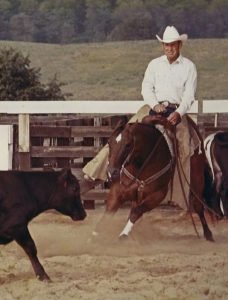
Cutting is all about the horse and rider’s ability to work as a team. Horse and rider are judged on the horse’s ability to separate a cow from a herd and prevent it from returning.
Roping
Roping is all about the horse and rider’s ability to quickly lasso and rope a calf. This is a great discipline for riders looking to test their horse’s speed and agility.
Breakaway Roping
Breakaway roping is a fast-paced discipline that requires the rider to quickly lasso a calf and then let go of the rope in order for the calf to be scored. This is a great discipline for riders looking to test their reflexes and their horse’s speed.
Western Trail (Show)
To compete in Western Trail, riders and their horses are required to navigate obstacles that may include gates, bridges, logs, rails, and other spooky elements such as a vinyl raincoat. The goal is to demonstrate the horse’s agility, obedience, and confidence in a variety of situations. In a trail class, riders will be judged on the horse’s overall performance, including its willingness to cooperate and take direction from the rider. Western Trail is an exciting event that can be enjoyed by everyone, from the beginner rider to the experienced equestrian. Riders of all levels can benefit from this competition, as the course is designed to challenge each competitor’s skills and abilities. Not only is participating in Western Trail a great way to get outside and enjoy the company of horses, but it’s also a fun and rewarding way to test your equestrian skills.
Team Sorting
Team sorting is a team event that requires the combined effort of the horse and rider. The goal is to separate a set of cows from a herd and place them in a specific order. This is a great discipline for riders looking to test their horse’s agility and speed.
Gymkhana
Gymkhana is an exciting event that combines speed and agility. This event is great for riders looking to challenge themselves and their horse.
Racing Disciplines
Welcome to the wonderful world of horse racing! People all over the world have enjoyed horse racing for hundreds of years. Even though the sport has changed over time, the basic idea hasn’t changed: horses race against each other to see who comes out on top.
Horse racing is all about seeing who can go the fastest. In competitions, horses of all shapes and sizes, from tiny ponies to big, strong thoroughbreds, take part. The type of horse used in a competition depends on the event, since different disciplines suit different types of horses.
Thoroughbred Flat Racing
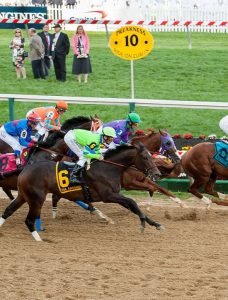
Thoroughbred flat racing is perhaps the most well-known type of horse racing. It’s the type of racing you see on TV and in movies, where horses and jockeys race around a mile-long track against the clock. The horses need to be in peak physical condition to compete. Flat racing is often the most exciting type of horse racing due to the horses’ speed and the close finishes.
It is well known for the Kentucky Derby, Preakness Stakes, and Belmont Stakes, all three of which are held in the United States.
Quarter Horse Races
Quarter horse races are a form of horse racing that is typically shorter in length than Thoroughbred races. Quarter horse races usually last between one-eighth and one-quarter of a mile and are usually run on dirt or turf tracks. These races are usually shorter in duration than other types of racing, and they typically involve a greater degree of sprinting. Quarter horse races are popular in the United States and some other countries.
Shetland Pony Races
Shetland pony races are a fun and unique type of racing with children on ponies. The ponies are much smaller than traditional racehorses, and the races are usually run over a short distance. This type of racing is often seen as part of an equestrian festival or fair, and the winner is typically awarded a ribbon or prize.
Harness Racing
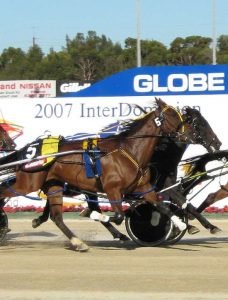
Another popular form of horse racing is harness racing. The races involve two or more horses pulling a sulky, or small cart, around the track at a fast pace. The horses race around a circular track, and it takes a lot of skill and strength to complete a course. This type of racing is usually seen in the United States and Canada.
Steeplechase
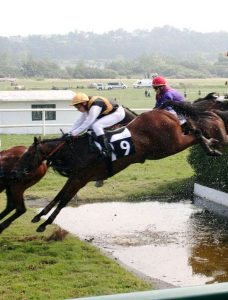
Steeplechase is a type of horse racing that is held over a long distance, usually between two and four miles. The horses must jump over obstacles during the race, and the winner is determined by the horse that reaches the finish line first. It’s an exciting and dangerous sport to watch, where the courage and skill of the jockey and horse can make all the difference between winning and losing. Steeplechase is popular in the United Kingdom, Ireland, and the United States.
Team Disciplines
Team riding disciplines and sports offer a unique opportunity for experienced equestrians and riders of all levels to come together and enjoy the sport together. Whether you are looking for a new way to challenge yourself or a way to spend time with friends, team riding disciplines and sports provide exciting opportunities to explore.
Polo
Polo is one of the oldest known team sports, played on horseback, in which players use mallets to hit a ball through goals. It is an exciting and challenging game that requires both individual skill and team coordination. The games are played by two teams of four people, move quickly, and require mental and physical agility.
Pato
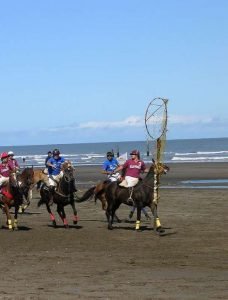
Pato is a traditional game that originated in Argentina. Players ride horses and use a long-handled mallet with a cup at the end to try and hit a duck-shaped leather object. It is a fast-paced game that requires skill and a strong team spirit.
Horseball
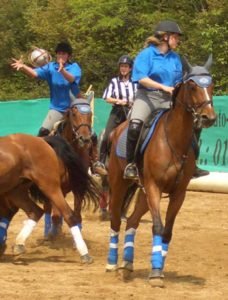
Horseball is a team sport that combines elements of polo and basketball. The objective is to pass a ball to teammates on horseback and try to score points by throwing the ball through a hoop. The team with the highest score at the end wins. It requires good coordination and the ability to think quickly and act accordingly.
Mounted Horse Games
Horse games are a great way to have fun and build teamwork. It involves a variety of activities and games that involve horses, such as obstacle courses, relay races, and team jumping. It can be both fun and challenging and is a great way to develop coordination, trust, and communication between you and your horse.
Equestrian Drill Team
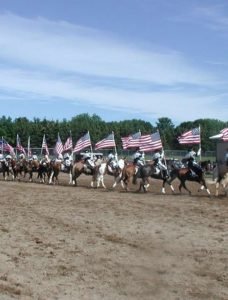
Equestrian drill teams are a great way to show off your riding skills and compete with other teams in a fun and friendly atmosphere. They involve a variety of different routines and patterns that are performed in unison by a team of riders and horses. It’s a great way to build teamwork and trust between riders and horses and show off the skills you’ve developed.
Para-Equestrian Discipline In The Paralympics
Para-equestrian sport is an exciting and accessible form of horsemanship that provides an opportunity for individuals with physical disabilities to compete in a highly competitive setting. Para-dressage and para-driving are two disciplines of para-equestrian competition that offer a unique and thrilling experience for competitors and spectators alike.
Although para-equestrian competitions generally focus on the rider or driver’s individual performance, para-equestrian sport has evolved into an internationally-recognized event and para-dressage is held as part of the World Equestrian Games. This recognition of para-equestrian sport serves to provide disabled athletes with exciting, competitive opportunities and an unparalleled platform to showcase their skills.
Para-Dressage
Para-dressage is a test of finesse and skill whereby a rider and their horse perform a series of predetermined movements and exercises. The goal of para-dressage is to showcase the partnership between horse and rider and demonstrate the horse’s obedience, agility, and responsiveness. The judging system is based on the FEI (Fédération Equestre Internationale) dressage tests, although the tests are modified to suit the individual needs of the para-dressage rider.
Para-Driving
Para-driving, on the other hand, focuses on the skill and athleticism of the driver and their team of horses. This discipline is an exciting spectator sport, as drivers navigate their way through a complex obstacle course using two, three, or four horses. The objective of para-driving is for the driver to work in unison with the horses and demonstrate their ability to control the team, as well as the accuracy and efficiency with which the driver navigates the course.
Driving Disciplines
Horse driving is an exciting, thrilling, and varied sport that requires skill, finesse, and dedication. It involves a driver, either an individual or a team, guiding one, two, four, or more horses to pull a vehicle, such as a carriage or wagon, according to a set of rules. This is a great way to become involved in the equestrian world, and to share your passion for horses with others.
Combined Driving
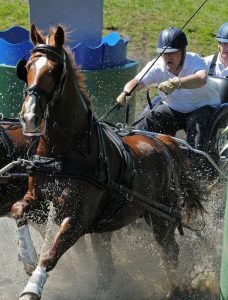
Combined driving is a discipline that involves a horse and carriage navigating a course of obstacles. It is a timed event that requires skill, speed, and precision. The horse and driver are judged on their ability to negotiate various obstacles, such as gates, cones, and other hazards. The horse-and-driver team that has the lowest score wins. This discipline is often used for competition and is a popular part of equestrian events.
Pleasure Carriage Driving
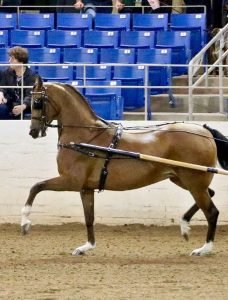
Pleasure Carriage Driving is a recreational activity that involves a horse and carriage. This discipline is typically used for pleasure rides and is a great way to relax and enjoy time with your horse. Carriage driving requires a great deal of skill and finesse to control the horse and carriage.
Fine Harness

Fine harness is a discipline of horse driving that involves a horse and carriage in a formal setting. This type of driving is often used for show or exhibition purposes. Drivers are judged on their skill and finesse in maneuvering the horse and carriage in a graceful and precise manner.
Draft Horse Showing
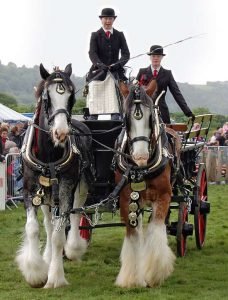
Draft horse showing is a type of horse driving that is typically used for exhibition and competition purposes. This discipline involves horses of the draft breed and focuses on the horse’s conformation and performance. Draft horses are judged on their ability to move in a specific pattern and show grace under pressure.
Roadster
Roadster is a type of horse driving used for racing and exhibition. This type of horse-driving involves a horse and carriage or cart. Roadster horses are judged on their ability to move at a fast pace and show speed and agility. This is a popular sport among equestrians and is often seen in horse shows and competitions.
Other Horse Disciplines
There is an amazing array of unusual horse sports out there, just waiting to be discovered. So if you’re ready to step outside the box, let’s explore a few of the more unusual equestrian sports available.
Trail Riding
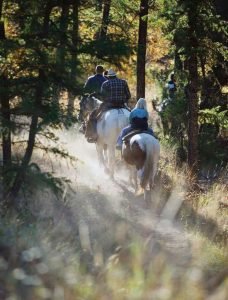
Trail riding is an outdoor equestrian activity that involves riding on trails, bridle paths, and forest roads, but not on roads regularly used by motorized traffic. It originated as an equestrian form of riding, usually called “trail riding” or “hacking” in North America, and “horse or pony trekking” in the UK and Europe.
Trail riding can be done alone or with a guide, depending on the area. Professional guides are often used in the USA at guest ranches, while many equestrians who own horses take part in local, state, and national trail systems. Trail riding offers riders a unique opportunity to explore the beauty of nature with horses, and is a great way to learn new riding skills.
Trail riding can be done in a variety of styles, including English, Western, and Australian. Each style requires different tack and techniques, and riders should be sure to check the regulations of the trails they are riding on, to ensure they are following proper safety protocols. Trail riding can be an enjoyable and rewarding experience for riders of all levels, from beginner to advanced.
Endurance Riding
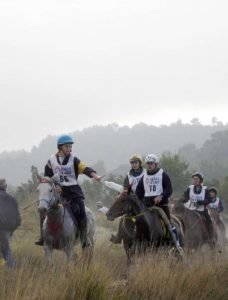
This type of riding is exactly what it sounds like—a test of endurance! Riders must complete a long-distance ride over varied terrain, such as hills and mountains. This discipline is all about testing the horse’s endurance, conditioning, and soundness. Riders must complete the ride within a certain time frame and make sure the horse is comfortable throughout the ride. Generally, the horse and rider that cross the finish line first win. Riders are judged on the speed, soundness, and condition of their horses. It’s a challenging but rewarding sport for both horse and rider.
Side Saddle
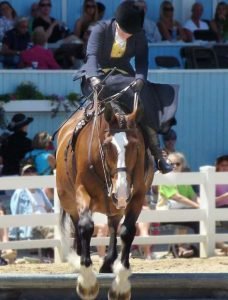
This is an ancient discipline that was popular among ladies of the Victorian era, when women preferred to ride sidesaddle for modesty. Riders mount from the horse’s left side and ride with both legs on one side. Riders also use a special saddle, known as a “side saddle,” that is designed to accommodate this position. There are both western and english side saddles. This type of riding is quite different from traditional riding and requires a lot of knowledge and skill. It’s a beautiful and elegant way to ride and is often seen in parades and other equestrian exhibitions. There are even side saddle competitions with jumping.
Skijoring
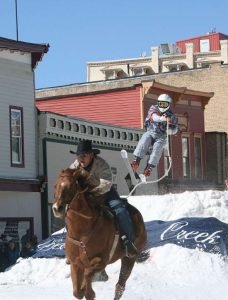
This type of horseback riding is a winter sport. Skijoring is a combination of cross-country skiing and horseback riding. Riders hitch themselves to a horse and ski behind it, holding onto the ropes while the horse pulls them around the course. The skier is pulled over the snow at high speed, usually for racing purposes. It’s a thrilling and unique way to use a horse and requires a great deal of skill from both the horse and rider.
Vaulting

Vaulting is an acrobatic performance that is performed on the back of a cantering horse. This type of riding is often seen in the Olympics and involves gymnastics on horseback. Riders must demonstrate their skill and agility as they perform various gymnastic maneuvers, such as somersaults, on the horse’s back. It requires strength, grace, and balance from both horse and rider.
Jigiting (Trick Riding)

Jigiting also known as trick riding is a form of stunt riding that involves performing acrobatic feats, such as standing on the horse’s back, while the horse is in motion. Trick riders must demonstrate both horsemanship and acrobatic skill to perform these feats safely. This type of riding is used in rodeos and circuses and involves riders performing death-defying stunts while on the horse’s back.
Native Costume
If you’re looking for a truly unique and eye-catching way to show off your horse, Native Costume Arabian Horses could be the perfect horse discipline for you. This form of showing involves dressing your horse up in traditional Arabian-style clothing and then riding it in a pattern around the ring. It’s a fun and entertaining way to display the grace and beauty of your horse, and it can be both challenging and rewarding.
Icelandic Horse Riding
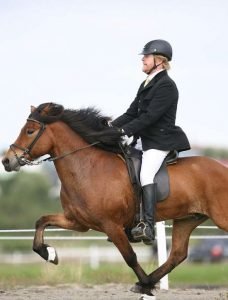
Icelandic horse riding is a traditional Icelandic discipline that involves riding the Icelandic horse.
This breed of horse is hardy and sure-footed, and riders must demonstrate their horsemanship skills as well as their knowledge of the breed to be successful. It has a unique style of riding that is fast, agile, and graceful. Riders must be able to master the five gaits of the Icelandic horse, which are the walk, the trot, the canter, the tölt, and the skeið.
Mounted Archery
Mounted archery is an ancient sport that tests a rider’s skill and accuracy as they shoot arrows from the back of a galloping horse. This is a thrilling sport for those who are looking for a unique challenge. The sport is popular in the Middle East and Asia and is gaining popularity in the West.
Halter
Halter classes are a great way to showcase the beauty and athleticism of horses. This type of competition showcases the conformation, movement, and condition of horses in halter classes. It’s a great way to observe the best of the best in equine conformation.Halter classes are divided into different type of horses. Sport horse breeds, stock breeds, action and gaited breeds, Arabians and breeds derived from Arabians such as National Show Horse, Morab and Welara, draft breeds, and other breeds such as Baroque breeds can all be found in halter classes.
Showmanship
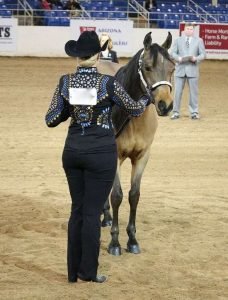
Showmanship is a popular horse discipline that can be seen in many horse shows. It is also sometimes referred to as “Fitting and Showmanship”, “Showmanship In-Hand”, “Showmanship at Halter” or “Halter Showmanship”.
Showmanship involves a person on the ground leading a halter- or bridle-wearing horse through a pattern of maneuvers. Unlike other horse disciplines, showmanship focuses on the exhibitor’s ability to present the animal to its best advantage and the quality of the grooming and presentation of both horse and handler.
Showmanship typically uses Western style horses, clothing and equipment; however, English styles may also be seen depending on the breed of horse. In some breed and open competitions, both English and Western handlers may compete in the same class. The major difference between the two is the outfits.
Miniature Horse Showing
Miniature horse showing is another popular discipline that is growing in popularity. As the name implies, this discipline involves horses that are much smaller than the average horse. Miniature horses are extremely adaptable and can excel in a variety of disciplines, such as driving, halter, jumping, and obstacle. Miniature horses are judged on their conformation, condition, presence, and performance.
Horse Pulling Competition
Horse pulling is a test of the horse’s strength and stamina. This competition involves horses pulling a weighted sled or cart. The team of horses must pull the cart or sled a certain distance in the shortest amount of time. It’s a thrilling and unique way to see how strong a horse can be.
Mounted Orienteering
Mounted orienteering is an exciting and challenging sport that combines horsemanship and orienteering. It is the practice of orienteering while riding a horse or other riding animal, often used in cavalry units and for mounted search and rescue. The rules of mounted orienteering vary according to the governing body but all focus on the rider’s ability to read a map and use a compass to successfully traverse the terrain. It can be completed competitively or as part of a multi-discipline sport such as Trec. The maps used are usually topographic and the riders must make the correct route choices, identify the correct control points, and adhere to the rules of the governing body. Mounted orienteering is an exciting and rewarding sport that rewards skill, knowledge, and physical fitness.
Liberty Horsemanship
Liberty horsemanship is a unique form of horsemanship that focuses on a strong, true, and free bond between horse and rider. It’s done without whips, crops, bits, or spurs, and even saddles are not recommended in order to maintain the bond. This is a great discipline for those who want to find a deeper connection with their horse and take their riding to the next level.
Hobby Horsing
Hobby horsing is a relatively new discipline that focuses on simulated horseback riding and is becoming more popular among young riders. Riders will use a stick with a plush horse head attached to it and perform a variety of maneuvers while pretending to be riding an actual horse. It’s a unique and fun way to show off horsemanship and have a great time.

FAQs Related To Horse Disciplines
English versus Western Style Horse Riding
Horseback riding is a popular pastime for many people, and it can be done in a variety of styles. Two of the most popular styles are English and Western. While each style is unique and has its own advantages, there are a few key distinctions that separate them.
The first major difference between English and Western horseback riding is the saddle. An English saddle is characterized by its flat seat, round pommel, and lack of a horn. On the other hand, Western saddles are typically built with a horn as well as a deeper seat.
The clothing worn by each riding style is also quite different.English riders typically dress in formal attire, while Western riders often wear more casual clothing.
Another major difference between the two styles is how the rider holds the reins. English riders hold two reins, while Western riders hold one. The reins used in English riding are usually shorter, with more contact with the bit. Western riders, meanwhile, prefer to ride with longer reins and less contact with the bit.
Finally, let’s consider the types of horses used for each style. English riders typically use larger horses such as Thoroughbreds and Warmbloods, while Western riders typically use smaller horses such as Quarter Horses and Paints. The size and breed of horse you choose will also affect your riding experience.
Is English or Western riding more expensive?
For those looking to get into horseback riding, it’s important to understand the potential costs associated with each discipline. English and Western styles of riding may require different gear and training, so it’s important to consider both the cost of the equipment and the cost of any lessons.
English riding is generally more expensive when it comes to the training and lessons required. Depending on the type of event you’re competing in, you may need three different types of saddles and other equipment. This can quickly add up in terms of cost. However, the tack and other equipment needed may be slightly less expensive than the western style.
On the other hand, western riding may require more expensive show clothes and tack than the English style. Due to the variety of competition types, show entries, equipment, and training lessons can vary in price for both English and Western styles of riding.
Overall, horseback riding is an expensive hobby or sport. Knowing the difference between English and Western riding and budgeting accordingly is the key to keeping your costs down while still enjoying the sport you love.
What Is The Most Popular Discipline In Horse Riding?
The most popular discipline in horse riding is dressage. It’s a highly skilled form of riding where the horse is trained to perform different movements with precision. Dressage focuses on the harmony between horse and rider and is a great discipline for anyone looking for a challenge.
What Is The Hardest Riding Discipline?
The hardest riding discipline is undoubtedly eventing. Eventing is a combination of dressage, cross-country, and show jumping, and is the ultimate test of horse and rider. It requires a great deal of skill, strategy, and physical strength from both horse and rider. Eventing is a great challenge for the experienced equestrian and can be very rewarding.
How Do I Choose A Riding Discipline?
Choosing a riding discipline can be a difficult decision. It’s important to consider your goals, the type of horse you have, your riding experience, and the type of environment you’ll be riding in. It’s also important to choose a discipline that you’ll enjoy so you can continue to improve and succeed.
Which Is The Most Dangerous Equestrian Sport?
The most dangerous equestrian sport is definitely steeplechasing. This sport involves riding at high speeds over large fences and obstacles and is extremely dangerous for both horse and rider. It’s also a very high-stakes sport, as the rider must have complete control over the horse for a successful run.

Wrapping Up
Horse riding is a wonderful activity that offers a variety of different styles and types of disciplines to choose from.
While it is important to understand the different disciplines and ask questions about them, the most important thing is to find a style of riding that works for you and your horse.
Whether you are a new or experienced equestrian, there is a style of riding out there for you to enjoy. So go out and explore the different disciplines and have a great time riding!
Cheers, Kacey

